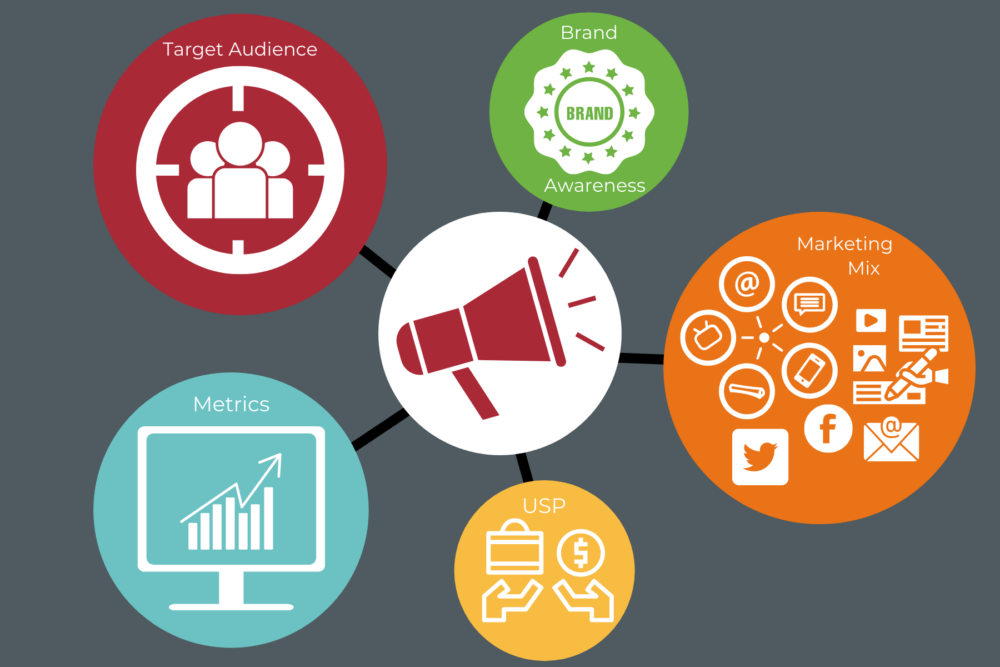Communication with customers is one of the main objectives of any business. Targeted at selling services or goods, companies need to settle effective interaction with consumers. The success of communication strategies highly affects the level of sales and revenues, which is why this aspect of business relations is a fundamental one.
Continuous interaction with clients is the main purpose of marketers. This business department aims to develop smooth and friendly interactions with consumers. Various measures and tools are applied to achieve this task.
The Fundamentals of Marketing Communication
By its definition, a marketing communication strategy is a set of steps and measures taken by the company to reach its target audience and ensure continuous interaction with customers. This objective is achieved by implementing various tools and techniques. The marketing strategy includes four main elements, namely:
- The message is what information you want to deliver to consumers.
- The medium is in what media or places to show your message
- The timing is the right time to show your message to reach more consumers.
- The audience is for whom your message is designed.
Note that while businesses used to use traditional communicational strategies just a few decades ago, the rise of digital technologies allowed bringing marketing communication to a higher level. Nowadays, marketers have a wider range of tools and technologies for the development and introduction of integrated marketing communication (IMC) strategies. Generally, digital marketing strategies stand as an advanced and effective way to communicate with consumers and promote products or services.

Crafting an Effective Marketing Communication Plan
The success in developing a highly effective marketing strategy determines the recognition and revenues of the company. Thus, this aspect of business running deserves particular attention and consideration. The development of a proper, well-reaching communication strategy requires time and effort. However, if you know all stages of the development process, you’ll cope with it quickly and easily. So, here’s a detailed guide on how to create a marketing communications plan.
Define Your Marketing Communication Objectives
Before you proceed to build the plan, you should prepare for it. Thus, the first phase implies the collection of the necessary information, with marketing objectives being the main one. A team of employees engaged in the development process should clearly understand for what purposes the strategy is developed. That is, they should understand what message should reach the target audience.
Conduct a Situational Analysis
Once you define clear objectives, analyze what you have at the moment and get input data for further application during strategy development. This phase implies the need to make an analysis of the target audience and consumer behavior on the market, the current level of income, and other business aspects.
Identify the Target Audience
When it comes to communication with consumers, you should perfectly understand your target audience. Create a psychological portrait of your client to identify his needs and ensure better reaching of his demands. Understanding your client is the main key to success since if you don’t realize what your consumer wants to get and what tools are more effective for reaching him, it’s impossible to build a working communication strategy. Make sure to take enough time to analyze your customer, identify his needs, and realize his psychology.

Develop Key Messages
This is when all the preparatory steps are over and all the required information is gathered. It’s time to proceed to message formation. Messaging is the key element the marketing communication strategy development. Formulate the main messages to be conveyed in the marketing strategy. At this stage, such tools as brainstorming are popular. All enrolled members generate ideas to build the perfect message that will reach consumers.
Choose the Right Communication Channels
The modern digital world provides a wide variety of communication channels. While a few channels were available earlier, nowadays, more options are provided. These include social networks, TV, offline broadcasting, etc. Select appropriate means of communication with your consumers. When choosing a suitable channel, analyze what social media customers tend to use more frequently.
Plan the Tactics and Activities
Once you’re done with the message, make a plan of content. A long-term interaction with consumers implies continuous holding of their attention and interest. Thus, content management is an essential part of integrated marketing communications. Develop tactics and activities that attract and retain consumers. If needed, a content manager is attracted.

Allocate Budget and Resources
Once the body is made, calculate how much funds you need to invest in order to implement the developed strategy. Make an estimate of the required resources to be attracted. Allocate funds for each aspect of the developed strategy.
Establish Metrics and KPIs
Before putting the strategy into operation, make sure to set metrics and KPIs to evaluate how effective the plan is. Thus, determine what result you want to achieve after the implementation of the strategy. List the key indicators of its expected effectiveness when the strategy will be fully applied.
Implement the Plan
Start introducing the strategy to clients. Follow the plan and integrate new tools step by step.
Monitor, Evaluate, and Adapt
Once the strategy is implemented, and its operation is in progress, continue monitoring its performance to assess its potential. Besides, the strategy may need adjustments or customization. Constant monitoring allows for evaluating its efficiency and adapting techniques timely.

Integrating Various Communication Channels
Nowadays, many different platforms are available for establishing interconnection with consumers. Besides standard ones, marketers can use:
- social media
- PR
- TV
- outside ads
The most stable communication with consumers is achieved by interconnecting several platforms and creating a branched chain across different channels. Thus, if you want to reach a wide audience and enjoy high involvement of customers, use several channels and interconnect them to build a single strategy. The combination of different platforms helps create a comprehensible strategy with a consistent introduction of business messages, which improves the level of custom engagement and system efficiency.
Content Creation and Storytelling
These aspects stand as modern tools for delivering business messages to consumers. These are advanced methods of communication with clients since they help create well-perceived unobtrusive messages.
Storytelling comes as a new way to interact with customers and deliver marketing information to them. Due to unobtrusive narration, such messages are better perceived without causing irritation. Instead, higher consumer loyalty is achieved. Wise storytelling allows for promoting services and goods less intrusive.
Content creation is a tool of storytelling. To ensure well perception of information, storytelling should alter different types of information representation (photo, video, facts, voice, etc.). The main goal of content creation is to develop a well-perceived chain of messages with the help of combining different visual and audio tools. Content creation allows for planning future steps in advance.

Measuring Success and Analytics
Marketing offers multiple tools to control and measure the effectiveness and success of an implemented IMC strategy. Depending on the domain and sphere of operation, metrics may differ. For instance, these can be:
- the level of sales;
- the percentage of leads;
- the amount of defective goods;
- customer satisfaction.
Usually, KPI metrics are developed at the stage of planning communication strategies. They help conclude on how effective the developed strategy is. The analysis of such metrics allows for adjusting the strategy timely and improving its efficiency.
The integration of innovative marketing approaches to business development helps improve communication with consumers and increase their involvement and satisfaction. By adopting improved techniques for communication with customers, businesses get effective tools for increasing income and embracing a wider target audience.





